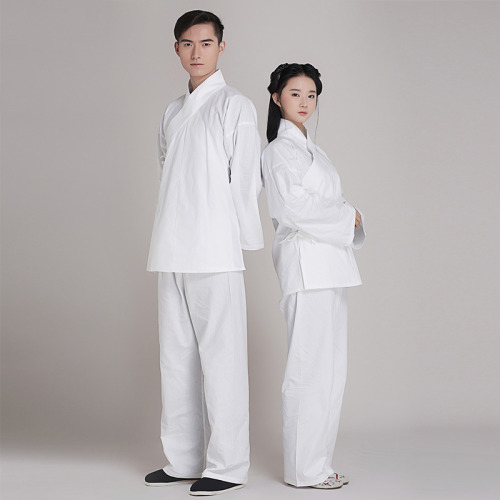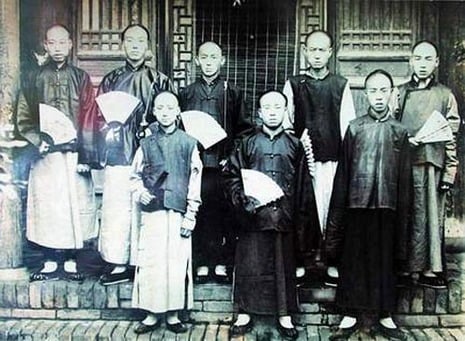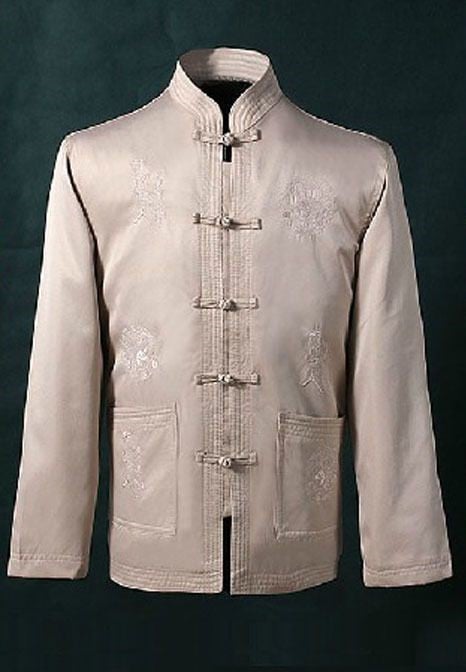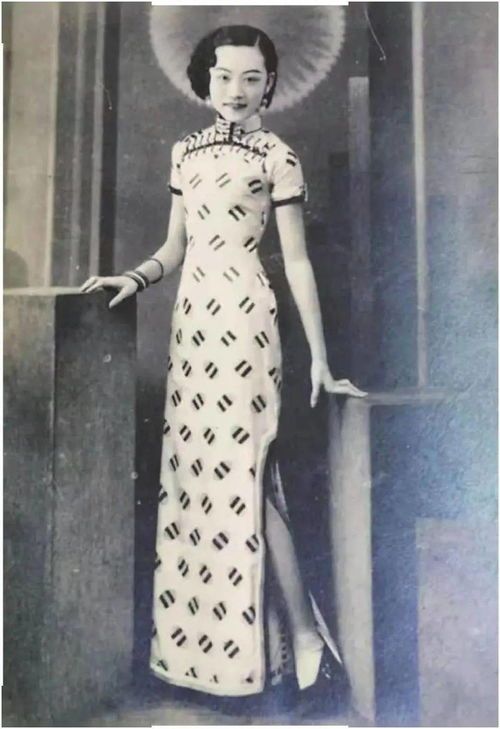As an ancient civilization with over 5,000 years of history, Chinese clothing reflects its cultural diversity, evolving tastes, and connection to the divine.
This blog post will explore the fascinating world of traditional Chinese garments and learn about their symbolism, craftsmanship, and the celestial inspiration behind their designs. From the elegance of dresses to the intricate embroidery of costumes, we will uncover these garments’ timeless masterpieces.
History of Traditional Chinese Clothing
The Origins of Chinese Traditional Clothes
Rooted in the belief in the semi-divine culture of ancient China, the origins of Chinese traditional clothing are closely intertwined with celestial influences.
Based on ancient Chinese historical records, when the Divine created man, he also imparted his culture to humanity, including clothing. Immortals from celestial paradises would reincarnate as humans during different periods. Many of these divine beings assumed influential positions as emperors and officials, shaping the land and its culture throughout various dynasties.
Alongside their wisdom, skills, and inventions, these divine beings brought divine gifts to humanity—including celestial garb. Some of these heavenly costumes can be seen in the ancient frescoes or murals of the Mogao Caves outside Dunhuang.

The heavens influenced traditional Chinese clothing—this unique relationship made historical Han clothing so diverse and rich in design. This inspiration from heaven led to the complex designs, symbols, and skilled craftsmanship that have come to define China’s long fashion history.
The evolution of Chinese classical costumes over time
The evolution of traditional Chinese attire through dynasties and periods highlights the nation’s rich sartorial history and its profound connections to culture, society, and the celestial world.
Chinese traditional attire has such origins, mainly inherited by the Han people. This heritage lasted from the Three Sovereigns and Five Emperors period and developed until the late Ming Dynasty, which had more than 5000 years of history.
The Han people are by far the largest ethnic community in China. Similarly to how the Chinese language (yu) is referred to as Han-yu, Chinese apparel (fu) is called Han-fu. However, traditional Chinese clothing has varied considerably between dynasties and ethnic groups.
As China’s semi-divine culture evolved through the ages, so too did its classical costumes, reflecting the changing tastes, socio-political climates, and technological advancements of each era.
Traditional Chinese Clothing Through The Dynasties
The traditional Chinese clothing system was not simply a matter of fashion or costume. It was a structured and detailed code of clothing that assigned specific attire to each social rank, gender, and role. Furthermore, the dress system also dictated the appropriate attire for various events and formal occasions based on the system’s guiding principles.
There are a lot of variations of Hanfu. The attire consists primarily of loose gowns, wide sleeves, and flat, crossed collars that are folded to the right. They were bound together with strings and secured with a sash belt. Hanfu was extraordinarily adaptable and simple to wear.
The Early Design of Traditional Chinese Clothes
The design of early Chinese clothing was relatively simple, consisting of a top shirt and pants or skirt below, collectively known as Yichang. Yichang is the word used to refer to clothing with: the Yi (衣) as the top shirt and the Chang (or shang – 裳) as the lower garment.
This is the foundation for later Chinese clothing styles. There were two basic forms of clothing styles during this period: Ruqun and Shenyi.
The Ruqun (襦裙) is a costume based on the design of Yichang. The top, or “Ru,” features a cross-collar design (called Jiaoling Youren – 交领右衽) and is typically form-fitting, while the skirt, or “Qun,” is long and flowing.
The Shenyi (深衣) is a combination of the Yi and Chang into a single piece, sewn together at the waist. That may be a full-length deep robe. This garment is designed with wide sleeves and a cross-collared design. All genders can wear the Shenyi. Its elegance and formality made it suitable for ceremonial, special occasions, and official events.
Society began to have a class hierarchy. Hence, there were stronger regulations for clothing patterns. The clothes’ color, decorations, length, and accessories indicated social position and rank.
During the Xia, Shang, and later periods, traditional Chinese clothing began to develop in terms of embroidery, printing, and dyeing. Clothing also has more diverse colors and textures.



Qin Dynasty
During the Qin Dynasty, the unification of China under Emperor Qin Shi Huang influenced attire styles.
One notable garment from this period was the Quju (曲裾). This is a type of Shenyi apparel, but it is worn differently. When unfolding, the width of the Quju is more than 3 meters. People must wrap it multiple times around the waist when wearing it. Hence it is also known as a three-layer robe.
Military attire became popular when China was split into dynasties and kingdoms. The Kaijia (铠甲) emerged as a significant piece of clothing during the Qin dynasty. The Kaijia is an armored coat featuring interlocking pieces of metal or leather to protect during battles. This practical and functional garment showcased the importance of military power and discipline during the Qin dynasty, laying the groundwork for the following unified empire.
Han Dynasty
During the Han Dynasty, people wore costumes based on Yichang and Shenyi, such as Ruqun, Quju, and Zhiju. They considered the Ruqun a more casual and comfortable alternative to the Shenyi. They usually wore the Ruqun with a long, intricate decoration belt. Their accouterments were quite delicate, showing their social class.
About the end of the Han Dynasty, women began to favor Banbi. The Banbi is a waistcoat or outerwear with short sleeves that people can wear over or beneath a long-sleeved Ruqun. This garment became part of traditional Hanfu and might have had many variations in the Qing Dynasty.
Han attire has very wide sleeves and a loose layered appearance, typically consisting of two or three garments, primarily a loose open cross-collar garment, a long wrap skirt, and a collar robe worn as the outer garment wrapped around the waist.

Late Eastern Han Dynasty to before the Tang Dynasty

(photo: Wikimedia).
This was the period when China experienced a time of political fragmentation, with numerous dynasties and kingdoms vying for power. Chinese traditional clothing continued to evolve and adapt, reflecting each dynasty and kingdom’s unique characteristics and influences.
However, amidst these changes, the core elements of the Hanfu remained constant, keeping the timeless elegance and sophistication of this ancient garment. The wide sleeves, cross-collared bodice, and flowing, long skirt with leg cover continued to characterize the Hanfu.
Tang Dynasty
During the Tang Dynasty, the Hanfu experienced a significant transformation. This period was known for its cultural openness and innovation, which is reflected in the vibrant colors and elaborate patterns in Hanfu designs.

Men in the Tang dynasty mostly wore Yuanlingpao (圓領袍), which is a round-necked robe (Quekua robes/缺胯袍), with a belt, and a head scarf called Futou (幞头), the trouser tucked into boots. This outfit became one of the official dresses and was popular until the Ming Dynasty.

People still used traditional cross-collar garments, but parallel-collar outfits were starting to appear. The Tang Dynasty also saw an increase in the use of silk and other luxury materials, further elevating the status of the Hanfu as a symbol of wealth and sophistication.

The design of women’s clothing in the Tang Dynasty always exalted the lightness and flexibility of what women wore. The materials used are usually thin and light to meet that requirement. The Qiyao Ruqun (齊腰襦裙) and Qixiong Ruqun (齊胸襦裙) became increasingly popular in this period.

Tang’s women showcased a remarkable diversity in various elaborate hairstyles and makeup, reflecting the era’s cultural openness and artistic innovation.

Song Dynasty
Men’s clothing of this time period was still based on designs from the Tang Dynasty. The Futou ‘head scarf’ of this period developed more square and stiff structures. Commoner men still wore cross-collared Ruqun and Shenyi.

In addition to the classic cross-collar top attire, Song’s women liked wearing facing or parallel collars (duijin clothes) such as Beizi, Duijin long cape, Daxiushan, etc. The Beizi (褙子) outer shirt with Songku (宋褲) trousers was a popular combination in daily life during the Song Dynasty. Women often wore outer clothes, revealing the Moxiong inner shirt and the coat’s wide-sleeved shirt outside.
Empresses and consorts wore Huiyi (袆衣) robes during the late Song Dynasty. People made it from luxurious materials such as silk and embroidered it with intricate designs of auspicious symbols. People often paired it with accessories such as Bixi (蔽膝) knee cover, Dadai (大带) large belt, jade pendants (玉佩), and Phoenix crowns. These further emphasized the wearer’s high status and divine beauty.

The most notable accessory was the Phoenix Crown, worn by the empresses. It featured intricate designs of phoenixes and other auspicious symbols. The crowns were adorned with pearls and foliage, decorations of dragons and phoenixes,… Empress’ ceremonial crown was even more decorated with fairies, which was called “Queen Mother’s fairy procession (王母仙人队),” and a diversity of birds, with a grander and more detailed scene.
Yuan Dynasty
During the Yuan Dynasty, the culture was exceedingly diversified, with many ethnic groups and attire coexisting, such as Mongol, Han, and Korean clothing. The Mongol attire was exceptional clothes for all genders. The Yuan Dynasty’s official dress code evolved into a hybrid of Han and Mongol clothing styles.

Ming Dynasty
Han ethnic majority regime was back in this time period. The Ming Dynasty marked a significant period in the evolution of traditional Chinese clothing, as it saw the reemergence of Han Chinese cultural elements after the foreign rule of the Yuan Dynasty.
There were some jacket styles in the Ming Dynasty, such as Daopao (道袍), Daofu (道服), Zhiduo (直裰), Zhishen (直身),… These were common, more usual costumes for men in daily life.

This was a period of great growth in goldsmithing and crafting techniques. Clothes began to use buttons instead of laces before. Costumes had become more sophisticated, with many collar variations, embroidery designs, and many types of fabrics. This period marked the appearance of the Pipa sleeves shirt (琵琶修) and Mamian skirt (馬面裙).
During this time period, jackets were also based on Beizi and Bijia/Banbi designs, with changes. Pifeng, an enhanced version of Beizi, and Bijia, a straight-necked vest, became the standard attire for Ming women.
Women’s accessories and jewelry were just as important as their clothing. For everyday wear or festivals, women would wear Yunjian (云肩). While Fengguan (凤冠/ phoenix crown) and Xiapei (霞帔) were often combined with a wedding dress or ceremonial dress.


Qing Dynasty
Traditional Chinese clothes underwent a tremendous transformation during the Qing Dynasty. Qing Dynasty fashion had different styles from the clothing system of previous dynasties. It was exceedingly intricate, with several laws and regulations.
The Manchu ethnic group was the governing elite at the period. They brought unique clothing styles and traditions, significantly influencing Chinese fashion. Their unique clothing combined practicality with elegance, reflecting their nomadic and martial background.

The official dress of the Qing Emperor and Empress was Chaofu. Its predominant color was yellow. The principal patterns are dragons for Emperor, phoenixes for Empress, etc. This clothing combines many sophisticated accessories, patterns, and jewelry.
The Manchu male hairstyle, known as the “queue,” was a distinctive feature of Manchu men. This hairdo involved shaving the front of the head and braiding the remaining hair into a long, thin tail that hung down the back.
During the Qing Dynasty, men wore mainly long garments, Magua (馬褂) tops, trousers, etc. Characteristics of the Qing Dynasty’s official clothing, including the Chaofu, were pi collars and arrow-shaped sleeves (horseshoe sleeves). Casual wear without horseshoe sleeves.
Manchu women wore the “Qi dress” (Qipao-旗袍) and “Flower Pot Shoes” (Madi shoes or “Horse Hoof Shoes”). Qipao had other names were Cheongsam (長衫) or Mandarin gown. Its outstanding features were a high neck and slit skirt. While the majority of Han Chinese ladies still wore clothing in the Ming style.



Chinese Traditional Clothing in Modern China
In the early 20th century, due to the influence of Western culture, Chinese clothing experienced further changes.
Chinese style jacket, the Zhongshan suit (中山装), or Mao suit (毛泽东装), emerged as a symbol of modernity and national unity. In this period, there was a mixture of traditional Chinese fashion elements with Western fashion styles. Men in government now wear both of these traditional Chinese jackets and suits as formal attire.


The enchanting modern Qipao (旗袍), or Cheongsam (長衫), evolved from Manchu women’s clothing, with its high collar, side slits, and form-fitting silhouette becoming an iconic symbol of modern Chinese femininity. Men’s clothing, such as the Cheongsam for males and Magua (马褂), also underwent transformations during this period. The Manchu-influenced Changfu (长服), consisting of a long robe and a vest, became the standard male attire for the court and the nobility.


The character of traditional Chinese garment
The Hanfu, a traditional Chinese clothing style, has a storied history that spans over 5,000 years. As an important part of traditional Chinese culture, the Hanfu has evolved and developed over time, reflecting various dynasties’ changing tastes and artistic expressions.
In the hierarchical society of imperial China, a person’s attire indicated their status. The colors and patterns of their clothing could determine the precise status of male and female members of the imperial family and all officials. People could quickly determine their status.
Materials
Chinese clothes are renowned for using luxurious and natural materials. Each material has a unique significance, and people choose it carefully based on its purpose, symbolism, and the wearer’s status.
The star is silk, a symbol of wealth and sophistication commonly used by the royal family. Clothes that need softness, lightness, and grace, such as Moxiong inner shirts, Daxiushan robes, Longhua scarf, etc., often use this material.
In northern China, with a colder and harsher climate, costumes would use more shirts and hats made from fur and animal skin. Other common materials include cotton, linen, and various types of brocades and satins, reflecting the craftsmanship and attention to detail in the construction of these garments.
Colors
The vibrant colors of traditional Chinese clothing reflected the nation’s rich cultural heritage. Each hue held symbolic significance. Red symbolized joy, and good fortune, while yellow represented power and was often reserved for royalty. Green signified growth and harmony, blue embodied immortality and tranquility, etc. These vivid colors and intricate patterns created a stunning visual feast, making traditional Chinese garments truly captivating.
Jewelry and Accessories
An elaborate system of jewelry and accessories often complemented Chinese traditional clothing. These items, made of gold, silver, jade, and other precious materials, emphasized the wearer’s social status and enhanced the overall elegance of the outfit. From intricate hairpins and headdresses to delicate bracelets and necklaces, these accessories played a crucial role in the overall aesthetic of traditional Chinese costumes.

Design and Patterns
The designs and patterns of traditional Chinese clothing were strongly rooted in the country’s history and culture. These garments often featured intricate embroidery, fine detailing, and symbolic motifs representing good fortune, happiness, and harmony. Traditional Chinese garments’ various patterns and designs conveyed the wearer’s social status, personal beliefs, and connection to the spiritual world.
Ancient Chinese clothing was intrinsically linked to the harmony between humans and the natural world. Simultaneously it reflected the admirable virtues that individuals should possess. For instance, the two-panel construction of garments with a vertical seam down the center signified the wearer’s integrity and uprightness, a visual reminder of the importance of leading an honest and virtuous life.

(Phone screen photo from Five Thousand Years.)
The term Jiaoling Youren refers to the custom of folding the left lapel of Hanfu over the right lapel. This rightward folding creates a y-shaped collar representing true Chinese beliefs and customs. On the other hand, if the collar is folded to the left, creating a mirror image of a y-shape, it is commonly considered the attire of a corpse.
The Divine Inspiration of Traditional Chinese Clothing
Traditional Chinese clothing is renowned for its rich and intricate designs, often adorned with sacred motifs that hold deep spiritual significance. These divine patterns showcase the harmonious blend of Chinese culture, beliefs, and artistry. One such emblem is the dragon, a symbol of power, strength, and good fortune, often reserved for emperors and other high-ranking officials. The phoenix represents grace and virtue. And the union of yin and yang is another popular motif that graces traditional garments.

Floral patterns, such as peonies, plum blossoms, and chrysanthemums, also hold divine connotations, symbolizing prosperity, resilience, longevity, and respectively. Chinese culture also depicted animals like cranes, deer, and bats carrying auspicious meanings, such as longevity, prosperity, and good fortune.
Taoist and Buddhist symbols, including the yin-yang and lotus flower, are often interwoven into the fabric of traditional Chinese clothing, reflecting the profound influence of these spiritual traditions on Chinese society. These sacred motifs not only enhance the beauty of the garments but also serve as a reminder of the timeless values and beliefs that have shaped Chinese culture for millennia.